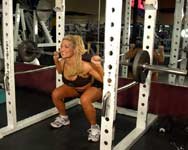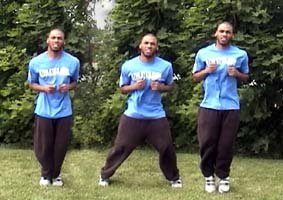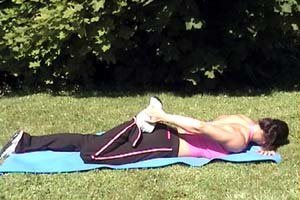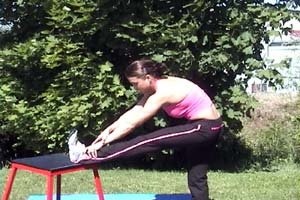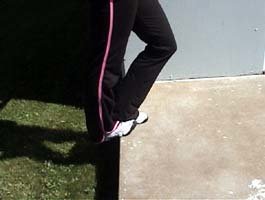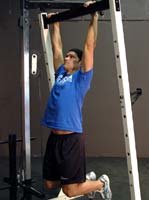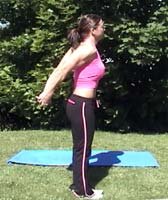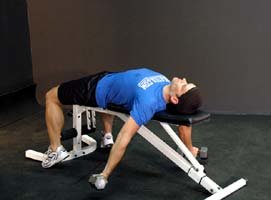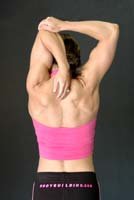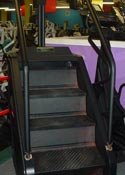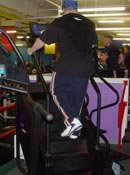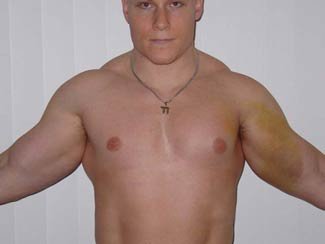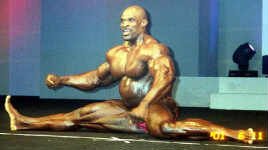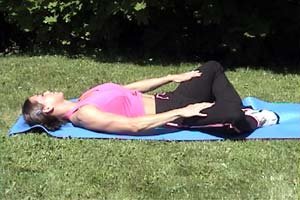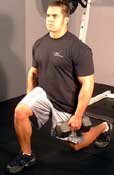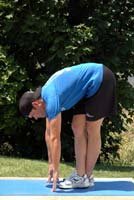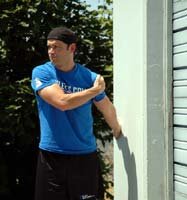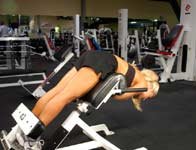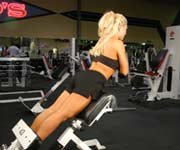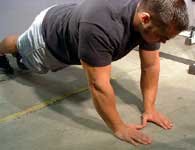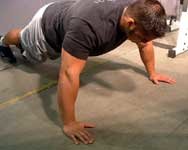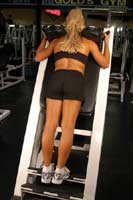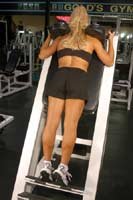
TOPIC: How Important Is Warming Up?

The Question:
Much of the time you will see people stretching out their legs before a run, or stretching out any body part before they train it. It's also very popular for people to begin warm-up sets before they really get into the workout.
How important is warming up before a workout?
Does stretching help prevent injury and soreness? Could it make someone more prone to injury through over-training?
What types of stretches do you perform before a workout? Do you stretch you whole body or just the body parts you are working that day?
What stretching routine do you follow?
How important is the cool down? Does it affect muscle recovery? Soreness?
Bonus Question: What are the best recovery supplements out right now? What is the most effective pre-workout supplement? Post-workout?
Show off your knowledge to the world!
The Winners:
- 1. sword chucks
- 2. TheMind
- 2. CsNut (Tie)
- 3. ravadongon
- 3. bigcalves (Tie)
View ProfilePrizes:
- 1st place - 75 in store credit.
- 2nd place - 50 in store credit.
- 3rd place - 25 in store credit.

1st Place - sword chucks

 The Forgotten Elements Of Training: Warming Up, Stretching, & Cooling Down
The Forgotten Elements Of Training: Warming Up, Stretching, & Cooling Down
 Introduction
Introduction
Warming up, stretching and cooling down correctly are fundamental, yet often overlooked parts of any training program. While these components to training are very basic, many people tend to skip over a proper warm-up, stretch and cool down program and wonder why they do not feel ready to work out. I call these aspects of training the forgotten elements of training because they are techniques that you never see much of in gyms compared to the amount of work done on heavy sets you see.
Warming up has many benefits. The main benefit to warming up is injury prevention because the blood will be pumping to an area, lowering the chance of a muscle pull or joint injury. Warming up isn't just a safety precaution though - it also has positive effects on a bodybuilder because after a warm-up, strength and focus should be peaked. Warming up has many physical and mental benefits.
Stretching and cooling down go hand-in-hand mostly because they come after a workout, whereas a warm up usually precedes a workout. Their main benefit is increasing recovery, and these activities also add to the overall health of the muscles.
This article will not only discuss the many ways in which a warm-up, stretch and cool down program is important, but it will also provide some methods to warming up, stretching and cooling down and some useful tips on how to do a proper but time-efficient warm-up!
While it will focus on warming up for a hardcore hypertrophy-inducing workout with weights, this article will also give methods of warming up for other activities such as athletic activities, a strength workout, or an endurance workout, and methods for a cool down and stretch that will maximize recovery and progress!
 An Injured Bodybuilder Can't Gain Mass!
An Injured Bodybuilder Can't Gain Mass!
An injury is the last thing any bodybuilder wants. You can miss a meal here and there if you absolutely must, you can skip the last 5 minutes of your cardio session if you need to be somewhere, but if you skip your warm-up and end up with a muscle pull, you're not gaining optimally for the next month or so.
Warming up is injury-preventative in many ways. It increases flexibility and blood flow which limits the chance of a muscle pull and joint pain. A proper warm-up also gets the lifter in a groove for their exercise.
 Increasing Flexibility
Increasing Flexibility
Warming up is a great way to increase flexibility before a heavy set. Training the muscles through an identical range of motion to the lift that is to be done stretches the muscle properly and prevents a pull of any muscle about to be trained.
Let's say a lifter is getting their legs ready for a set of full barbell squats, 355 pounds for 5 reps. They get into the gym and their legs are a bit tight. They head over to the squat rack and get under the bar. They squat down and can hardly get to parallel. Luckily, they can push a light weight back up.
If they had skipped a warm-up and jumped right into 355 pounds, it would have pushed their legs past the maximum stretch point and chances are a muscle pull would result.
 Lubricating The Joints
Lubricating The Joints
So the same lifter decides to hit the treadmill for 3 minutes to get the blood and oxygen pumping into their legs. When he gets back to the squat rack with his warm-up weight, he finds himself much more flexible. After twelve warm-up reps his knees are completely lubricated as well, and there is no cracking or popping to be heard.
 "Getting Into The Groove"
"Getting Into The Groove"
Getting into the groove for an exercise is also important. Take as many sets as you need until the form for an exercise feels natural. Once all the kinks are worked out, a proper warm up has been completed. So, let's get started!
 Warming Up For Optimal Results
Warming Up For Optimal Results
A lot of times a lifter will get to the gym and get right into their heavy sets with no warm-up. Then they come on Bodybuilding.com and read this article. "Okay, I'll do one warm-up with the bar, that will help a lot I guess". Maybe it helped a little bit but a proper warm-up can do you a lot better.
Step One Of The Warm-Up
- The first focus of a warm-up should be to give the muscles a light pump. This is best accomplished by completing 1-2 sets of 8-12 reps with a very easy weight.
This step will make the muscles ready for heavy warm up sets and eventually the working sets. It will also get you in the groove and in the mood to lift. So for our lifter squatting 355X5, his first two sets could look like this:
- 135X12
- 225X8
Step Two Of The Warm-up
- The next step in the warm-up is to get your muscles ready for heavy weights to failure! The next two sets should come pretty close to the weight that will be used for the first working set, but will only be 1 or 2 reps - this is so that you don't fatigue your muscles and so you don't induce any micro trauma too early. These two sets can look like this (for our 355X5 squatter):
- 275X3 325X1-2
Step Three Of The Warm-Up
- What could come next? I know what you're saying. "Don't say the next step in the warm-up is the working set!" No, that is not it! The next step is to make sure you get a FULL 2-3 MINUTES REST after your last heavy warm-up. This will let the minimal amount of fatigue that did occur clear out but is also a short enough time so that the muscles maintain elevated blood flow.
 The Total Warm-Up
The Total Warm-Up
 How You Should Feel As It Goes On
How You Should Feel As It Goes On
- 135X12 - This should feel a little uncomfortable and a lot of times a lifter will feel weak here.
- 225X8 - This is work but you should start feeling stronger.
- 275X3 - Wow! This feels very heavy for you! But it's just a mental block that will be eliminated. That is why a heavy warm-up is beneficial!
- 325X1 - This set should feel a little heavy but solid.
- 355X5 - After you are prepared from all of those warm ups this set should feel solid.
After this, you do not repeat the warm-up process! Simply continue doing heavy sets (most lifters do 2-4 sets of one exercise).
After you have done a warm-up for one muscle group you do not need to do an in-depth warm-up for each following exercise. For example, if the next exercise is stiff-legged deadlifts, a light set of 60% of the working weight for 8 reps is an adequate warm-up.
Another point to note is that it is best to warm-up each muscle using the first exercise that is to be done. For example, if it is your leg day and you are doing squats first, don't use the leg extension to warm up - get in that squat rack and do a few sets! This will increase flexibility to the specific exercise and will also increase body awareness for that exercise.
At times a weight will feel oddly heavy or oddly light due to various reasons. If this ever happens just perform another warm-up set with the weight and the heavy feeling should go away. The best way to enter a working set is with a sense of confidence and strength without fatigue and that is what this warm-up method accomplishes.
 Getting Your Nerve Through a Warm-up Routine
Getting Your Nerve Through a Warm-up Routine
Have you ever felt nervous or edgy before a big set of squats on leg day, or in the hour before you go for the new deadlift record? This always happens to me personally. It is natural. Why does it happen? Who knows? Maybe thousands of years ago, underdeveloped primates were crushed as they carried heavy items back to their caves in a squat position. These days we have squat racks which prevents this from occurring, but whatever the reason, we must overcome this.
During my warm-up sets I like to take that time to get my nerve together. For squats, deadlifts or bench presses my warm-ups sometimes take around 10 minutes, and this is a good time to get your head on straight and realize that the set is coming.
If you follow the warm-up as described above, you should find that you feel much more confident with the heavy weight because you were acclimated to it already.
 Warming Up For Other Activities
Warming Up For Other Activities
This article is mainly focused on warming up for a bodybuilding workout. However, as a bodybuilder, in our quest to fitness we want to perform optimally in anything we do and more importantly finish it injury free.
Warming Up For Sports
- To warm up for sports, a sport specific warm-up is usually best. Just like squatting is not a good warm-up on chest day, playing kickball is not a good warm-up on a day of tennis practice.
Instead of going into a bunch of different sports specific warm-ups which has no meaning to all of us bodybuilders (unless the warm-up is for a posing routine) I will just say that a general total body warm-up benefits any athlete.
This total body warm-up can consist of light exercises with dumbbells, but most of the time the warm-up is things like 20 jumping jacks, 20 push-ups, 20 sit-ups, and 3 laps around the field. This gets blood flowing all over since all areas of the body are used in a sport.
Warming Up For Maximal Strength Performance
- The thought that bodybuilders should focus on strength gains over all other things is spreading. We want to do whatever we can to use the most weight we can and cause micro trauma in every single workout! So a strength-training warm up is a lot like the bodybuilding warm-up outlined above.
Some things differ though. For strength training, more warm-up sets should be completed, but each one should only be of a very low rep count. This prevents fatigue.
Stretching should not be done because it will put the muscle in an un-contracted position, weakening it. It may be of some benefit to stretch opposite muscle groups to the ones about to be trained (such as hanging from a pull-up bar before your set of military presses). If a muscle is very tight, lightly stretch it.
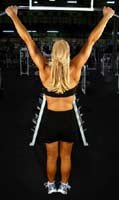
 Click To Enlarge.
Click To Enlarge. Hanging from a pull-up bar before your set of military presses can help prevent injury.
Finally, do not spend unnecessary energy on the treadmill or the elliptical bike- just get right to the lift. Maxing out on an exercise requires maximum energy and specific focus on one area.
Warming Up For Endurance Performance
- This one is kind of funny. How do you warm up for a jog? In most cases, a jog is a warm up! You might do a little walking to start but really, most people just jump right into a jog. It is the same way with a very high rep weighted exercise or any other endurance activity.
Most of the time, before performing an endurance set it is alright to jump right in, but one set prior to performing the exercise will help you get focused and make sure your form is perfect.
 Benefits To Stretching
Benefits To Stretching
Just like people underestimate the importance of a proper warm-up, many underestimate the importance of stretching. Seems like all most lifters want to do is jump right into working sets and then leave! Taking some time after a workout to stretch can be just as beneficial as taking time before a workout to warm up and acclimate to an exercise.
Stretching can prevent a lot of problems such as muscle tightness, muscle soreness, and the common problem to bodybuilders known as becoming "muscle bound".
Preventing Muscle Tightness & Soreness
- There is a sort of scale that the muscles have that pertains to how stretched they are or how contracted they are. On one end is an extremely stretched muscle. On the other is an extremely contracted muscle.
A healthy muscle lies somewhere in-between. While working out a muscle becomes extremely tight - A proper stretch routine can limit this tightness, thus preventing injuries.
It is a proven fact that stretching decreases the amount of muscle soreness after a workout. Not only is it proven scientifically but many lifters have experienced it. To effectively limit muscle soreness, the price might be a very painful stretch, but this is what we call "temporary pain, long term gain".
What is worse, gritting your teeth and doing a 60 second stretch after training each muscle group, or having to grit your teeth because it hurts to do simple activities because of muscle soreness all day?
Muscle-Bound What?
- It is a common idea that from all of our working out, us bodybuilders become completely inflexible and "muscle bound". But this is no myth! If you do not stretch, you will fall victim to this trap! It might not be as bad as it sounds but why lose flexibility? It will only affect you negatively.
Look at bodybuilders like Tom Platz and Arnold Schwarzenegger. These are two bodybuilders that relied heavily on stretching. Arnold always said that to get a fully developed muscle you need to stretch.
Both bodybuilders based their stretching routines on the fact that the more a muscle stretches, the stronger it can contract. Arnold states that "Bodybuilders like Ed Corney, known as perhaps the best poser in modern bodybuilding, could never move with such beauty if their muscles, tendons, and ligaments were tight and constricted." (150, Schwarzenegger)
It is also proven that as a bodybuilder develops; the muscle separation suffers due to gravity and other reasons. Stretching is the cure for this problem! Over time, stretching can greatly aid a bodybuilder's muscle separation. It might not show right away but when you hit the stage you will be glad you took time to stretch out.
 Stretching Routine
Stretching Routine
What? We need a warm-up routine, a weight lifting routine, and a routine for stretching? Yeah. Getting a routine for your stretches will help any bodybuilder to be more consistent with it because it isn't just something you do on occasion any more, you are now integrating it into your schedule.
Stretching Before A Workout
- There is a lot of controversy these days about pre-workout stretching. The truth is that it will not make a huge difference if a bodybuilder does some light stretches before a workout. But do you remember that scale of stretching that I mentioned before?
Before a workout, to achieve an optimal muscle building environment for a bodybuilder, or optimum strength for an athlete or strength-focused lifter, healthy muscles that fall close to the middle of that scale is what we want.
If you stretch too much you put the muscles in a non-contracted position, which will hurt performance. However, at times a stretch can be very beneficial. If a muscle is too tight a stretch can loosen it up enough so it is in a healthy state.
Finally, before a workout there is not as much blood pumping to and from the muscles as after a workout, which is why it could cause pain or injury.
Stretching After A Workout
- Directly after a workout is the best time to stretch. You will not have to worry about possibly hurting performance. Also, after a workout the muscles are very tight.
Finally, the muscles are pumped up with blood and oxygen, giving them a better range of motion. After a workout stretching will greatly benefit you while any negative effects would be prevented.
Stretches For Each Muscle Group
- Stretching of a muscle is cause by the pull of an antagonist muscle. After the negative phase of an exercise, or the lengthening phase, the muscles are fully stretched. Therefore, a good stretch for any muscle is simply relaxing at the end of an exercise. For example, after your set of pullups, just hang there, and this will stretch out your back and biceps nicely.

Jean-Pierre Fux Was Squatting 695lbs In A Flex Magazine Photoshoot When Suddenly Both Legs Collapsed. He Tore All Four Quadricep Muscles In His Left Leg & His Pattella Tendon In His Right Leg.
Some exercises do not lend themselves so much to stretching though. Would you want to let yourself get squashed by a barbell in a squat position for 60 seconds? I know I would be more worried about balance than the actual quality of the stretch. I will give some simple stretches for each muscle that are safe.
 Quadriceps Stretch
Quadriceps Stretch
- Lying on stomach with thighs together, reach back and gently pull one ankle toward the buttocks until stretch is felt. Hold 30 seconds or more. Repeat with other ankle.
 Hamstring Stretch
Hamstring Stretch
- Put one foot up on a high bar and lock your leg out. Then try to touch your head to your knee. This stretched the hamstring at both joints, making it very effective.
 Calf Stretch
Calf Stretch
- Get on the edge of a machine at your gym where you can let your heel go as far down as possible. Then stretch to the limit and lean forward. You will really feel this!
 Lat Stretch
Lat Stretch
- Hang from a pullup bar with straps for a 60 seconds. Pretty simple and safe. Try varying up the grip for full development! Another thing I like to do is grab onto a doorknob or the edge of a machine and extend to a full lat stretch and then twist my body. This really hits my lower lats as well.
 Biceps
Biceps
- Clasp you hands together behind your back. With arms straight and fingers interlaced, raise arms until stretch is felt. Hold 30 seconds or more.
 Chest Stretch
Chest Stretch
- I like to use dumbbells for this (well actually I don't particularly like any stretch but you get the idea). I get on the flat bench and face my palms towards myself and then arch my back really hard and push my shoulders back as far as possible.
After 40 seconds, I take 20 seconds to lower the weights with my biceps so it has an effect like a dumbbell fly.
 Shoulder/Tricep Stretch
Shoulder/Tricep Stretch
- This is a more traditional stretch. I put an elbow behind my head and push it back while holding onto the same limb with my other hand. Pretty simple, you have probably seen a lot of people doing this already.
 My Stretching Routine
My Stretching Routine
Something that is more useful for us bodybuilders to know is that stretching will increase the muscle size greatly by expanding connective tissue, giving it more room to grow.
Arnold and many others believed in this technique and called it "fascia stretching". My experiences with this have been great. I saw a huge difference in my muscle development after I added in these stretches- in fact, once I incorporated these, my weight gain began to skyrocket again after I had been stuck at the weight for 1 month! Coincidence? No such thing as a coincidence!
I use all of the stretches above but only those stretches that can target every muscle effectively. There is no need to take time to stretch out the forearm extensors and flexors and other small muscles such as those.
After the last set for each muscle group in a given workout, I immediately go to my stretching station and perform a stretch for about 60 seconds. For the first 15-30 seconds I am easing into it and in the last 45 or so I am really feeling the pain but I push (not the best word choice mind you) through. Make sure you can look at a clock during these or you will cheat yourself!
Before training a muscle I feel that simply completing a few warm-up sets through a full range of motion is enough to adequately stretch the muscles.
If you want to stretch before training make sure to warm up first. My coaches always said "you don't stretch to warm up you warm up to stretch." Remember, don't stretch the muscle too much or you will not allow maximum training results!
My stretching routine has caused explosive growth all over my body. I am still more or less a scrawny punk compared to the bodybuilding greats, but I was amazed when I saw the results from just incorporating one minute of stretching into my workout!
 Benefits To The Cool-Down
Benefits To The Cool-Down
Like I said before, stretching and cooling-down go hand-in-hand. They allow the muscles to get back to a normal state after training.
Think of a sport practice. After a hard workout loaded with sprinting, hitting, and focusing, an athlete is usually jittery with a highly elevated heart rate. It is beneficial after this to take some time to "unwind". It is the same for a bodybuilder after any workout.
How Important The Cool Down Is
- I am going to be honest here. The cool down is NOT the most important part in any training program. However, myself and many others encourage it just because it is worth the one or two minutes that it takes to do a proper cool-down.
A cool-down can simply be one light, high rep set for each muscle group to further prevent the muscles from being over-tightened.
Cooling Down & Recovery
- As stated before, a proper cool-down can allow the muscles to lengthen and return to a normal state faster than they would if you had not cooled down. If you stretch properly, that will limit muscle soreness greatly.
If you then take the time to cool the system down you can pretty much kiss soreness the day after a workout good-bye (unless you have not trained for the past month or more- but it will still help a great deal!)
As bodybuilders or athletes, we want to do all we can to maximize recovery and maximize the amount of growth we can get in during a short time frame, so we should take every action to maximize recovery!
 Conclusion
Conclusion
I hope that after reading this article, you understand the many ways in which warming-up, cooling down and stretching are important. I also am confident that you learned a few tricks to build your own warm-up, cool down, and stretch routine, or if you already have some you can now add some new techniques to them. The methods explained in this article can be useful for people with any type of goal!
Overall, warming up does prevent injuries and maximize lifting performance. Warming up isn't just a safety precaution though- it also has positive effects on a bodybuilder because after a warm-up strength and focus should be peaked. Cooling down and stretching follow a workout and increase recovery greatly while also adding to overall health of the muscles.
Warming up, stretching and cooling down properly are often overlooked yet integral parts of any training program. They are very basic and traditional aspects of any athletic activity, but are often overlooked in the gym where they can be even more beneficial than in the field. These elements of training should become more commonly used in the future by those wishing to maximize performance and recovery! If you have time to exercise, you have time to warm up and cool-down/stretch!
 Bonus
Bonus
Recovery Supplements
- Before I go into actual supplements, I will take the old-fashioned route and say that nothing will aid in recovery like a calorie surplus and a lot of carbohydrates, especially around workouts. Basic food is what makes the difference; supplements just add tiny bits here and there for the most part.
- Taking an EFA supplement will naturally boost testosterone levels. Omega 3, 6, and 9's come in pill form and will help recovery in many ways.
- This isnt a supplement but - Another thing I noticed is that ever since I began consuming 2-4 whole eggs per day, I have felt a lot stronger. Feels like more testosterone to me!
- A simple creatine supplement is known to maximize ATP production so that the muscles readily become prepared for the next workout.
- Citrulline Malate is called the "new kid on the block" as far as performance enhancers go. This product has effects ranging from limiting waste product build-up to increasing Nitric Oxide production. Both of these things help the body in the recovery cycle.
Pre Workout
- Pre-workout energy and focus boosters have been getting great feedback recently. SciVation, a great company with a lot of kind people behind it, has produced Neurostim.
This product increases alertness and focus in a workout. You can imagine how much this will benefit and if you are having one of those days where you are dogging it in the gym you will wish you had bought neurostim!
MRM's Driven has similar effects while also packing some body composition-helping effects.
Taking a shake with amino acids and glucose is proven to greatly increase availability of both before a workout. This will really improve performance in any activity.
The glucose provides a "carbed-up" feeling while the amino acids, which means things like glutamine and Taurine, will further aid energy and strength!
Post-Workout
- There are two things to think of post workout.
- You should look to replenish muscle glycogen. This will increase the muscles' energy for the next workout (not to mention post workout carbohydrates get sapped up into the muscles like water into a sponge).
- Think of reversing the catabolic processes that take place after a workout.
Dextrose does both things. Dextrose is the one carbohydrate that has the biggest effect on muscle glycogen stores and is the fastest absorbing.
What I recommend is to sip on a glucose and amino acid solution through your workout. Nothing too major, just 20-30 grams of glucose and 10 grams or so of amino acids.
You can also put in any other supplements you use such as your creatine or citrulline malate and create a great recovery-aiding cocktail.
The main thing to think about post workout is not how many milligrams of Super Placebo RX you get in but getting in a good amount of carbs and protein so you feel re-fueled and simple supplementation can accomplish this just fine.

2nd Place - TheMind

 Picture This
Picture This
You wake up to the dreadful sound of your alarm clock. "Ugh, is it 7:00am already?" Groggy, you wipe the sleep from your eyes and climb from bed. Your feet feel like lead slabs as they hit the floor below you. Without missing a step you walk over to your bedside power rack and squat 400 lbs. for 8 reps. It's now 7:02AM, time to start the day.
Sound like your morning? Doubtful. You may be a monster in the gym, but few men could perform such a feat directly out of bed. I love stating the obvious.
But whilst this may seem common sense that you wouldn't perform your best straight from a period of rest, it is a fact far too often overlooked in the gym.
It happens every day: Joe Schmoe gets off of work, drives to the gym, walks from the his car to the locker room, puts on a pair of shorts and thinks he's ready to have an intense, muscle popping workout. He may as well have just climbed out of bed, that's about how ready his body right now for his workout. By neglecting a proper warm-up, he's already shot himself in the foot... and chances are you do it too. Houston, we have a problem.
 Why Warm Up?
Why Warm Up?
You want the obvious? Yeah, I can do obvious. You see the obvious answer all the time: Mr. So-n-so's complaining about how agonizing this pain in his back is. He hurt it lifting a case of pop out of his wife's trunk after getting groceries. What? A case of pop!
Injury prevention is the number one reason to warm up. How's that for obvious. But yet injury happens all the time; people hurting their backs via such evil means as boxes, groceries, and unfortunately, weights.
The lower back is especially vulnerable due to its common use in extended and weak positions, sure, but why are there so many sad injuries that have occurred to most at some point or another?
"Lift With Your Legs, Not Your Back"
- Oh, you know you've heard that before; so called "words of wisdom" to prevent injury to your back. So why's it so dangerous to use you back to lift a laundry basket, but later that day it may prove to be perfectly safe for you to straight-leg deadlift 300lbs for 8 reps? That's the power of a warm up.
The main goal of your warm up is to get the juices flowing. That's right, crack open that Tropicana and let loose, safely. Warming up increases your heart rate and gets blood flowing more freely to otherwise "cold" muscles that are weaker and more prone to injury.
It's called a "warm up" for a reason: you will consciously notice an increase in temperature and limberness. Your muscles will experience an increase in blood, and essentially oxygen, availability and will not only become lengthened and more relaxed, but also will increase their ability to contract to its fullest extent.
 The Automobile In The Gym
The Automobile In The Gym
You don't have to be an automotive engineer to know that your car gets better gas mileage once the engine has been run for a while and heated up. It's a widely known fact that after warming up your car's engine becomes more efficient. It'll run cleaner, spark hotter, and show greater horsepower and gas mileage.
Your body is exactly the same; after a proper warm-up you'll run more efficiently: effectively preventing injuries, maximizing your strength, and getting the most from your body's fuel. The question is, are you Built Ford Tough?
You'll see a warm-up in nearly every sport that man plays, and with good reason.
- Hockey players skate gently across the ice warming up their leg muscles.
- Baseball pitchers have their own area of the stadium where they can gradually progress from playing soft-toss catch to pitching 100mph fastballs before taking the mound during the game.
- Tennis players start by volleying and gradually working their way up to full speed.
- Boxers will hit punching bags and jump rope just moments before entering the ring and basketball players will shoot hoops and rebound before a game.
- Football players will... well, what won't football players do to get themselves warmed up and psyched?
- Hold 'em players will, well, stare blankly into space with no emotion. Get the point yet?
No, but I think we've helped to demonstrate a very important factor of a warm-up which addresses one of the main reason people will state for not warming up. Your warm-up will burn up some energy, that's all there is to it.
When asked why they don't warm-up, most people will respond that they don't want to waste their energy: They're "saving it" for their full strength lift.
Here's Some News
- If you're not warming up, you're not performing your full strength lift. Spend a little energy to get warmed up, and it will release more energy within you than you've spent. Put in a penny, and get back a nickel. To all you non-Finance Majors out there, that's a good investment.
You want the most from your workouts? That wasn't actually a question, but a statement. So why risk injury and rob yourself of your full potential by skipping a proper warm-up? Bodybuilding is a Man vs. Self scenario, there's no room for excuses, so don't make them.
If you are even mildly serious about the time you spend in the gym, you will be sure to always warm-up properly. If you can't prepare yourself for a real workout by warming-up first, you may as well go home with a tub of Ben & Jerry's: At least you won't hurt yourself lifting your spoon, as you may have done in the gym without warming up.
 So How Do I Warm Up Then?
So How Do I Warm Up Then?
However suits you best. Experiment: try a variety of different stretches and exercises and find what gets your engine ticking. There are so many different ways to prepare for your workout that it's impossible to list a "perfect" way to warm up for your workout. Instead, however, we can examine the most common "tried and true" ways to get your juices flowing.
A proper warm up will always do two things: get your blood moving, and stretch your muscles.
Said The Heart To The Blood. "Ye Shall Move! I Command Thee!"
Back To The Obvious
- It's a warm-up because your body temperature will actually rise when you warm-up properly. More obviousness? Sure! This rise in temperature is due to the increased blood flow to the muscles of your body.
When you use a muscle, it requires oxygen and requests that the heart provide the necessary blood to accommodate this increased oxygen requirement. So if you want to get the blood flowing, you've got to use a muscle first. I know, it's like rocket surgery or something.
Let's face it, if your quads are not your biggest muscles then you need to reconsider the way you're sculpting your body there, Michelangelo. I cannot think of a more effective way of warming up the entire body than running, and would challenge someone to give me a comparable warm-up exercise.
Running requires the heavy use of your quads and other leg muscles which will quickly promote increased blood flow throughout the body. Running also uses (to a much smaller extent) a lot of other muscles in the body: Shoulders and arms, abdominals/obliques/back; nearly all muscles in the body are stimulated to some degree by running, thus it quickly stimulates the blood flow we're looking to achieve.
There are other alternatives, of course. Everything from walking up an incline, using a stair stepper, riding a bike, etc. It is a personal choice; find what suits you best.
So how long do you need to warm-up? Again, personal comfort is the dominating factor here. You should be able to tell when you are properly warmed-up.
You'll normally be sweating to a more or lesser extent, feel an increased body temperature, and most importantly feel loose and energized. I normally run for about 10 minutes on an indoor track before proceeding with my warm-up and workout.
 "Be Strong. Be Flexible. Be Immortal."
"Be Strong. Be Flexible. Be Immortal."
We've all heard about the 'stereotypical' bodybuilder. Or even worse, perhaps even recited those dreadful words ourselves:
Ouch. And what hurts most is that you know you've heard those very words before. And hey, there's absolutely nothing wrong with a fanny pack and spandex! If that's your thing then go for it.
There's one thing in there we must all be able to prove wrong: a Real bodybuilder has the flexibility to wipe his or her own backside without difficulty.
In fact, it is nearly always true that bodybuilders do (as they should) have more flexibility than the average person. This excludes gymnast and dedicated yoga enthusiasts, of course
However, building muscles will not make you more flexible. But lucky for us, being more flexible may help us build muscle Increasing your flexibility will benefit your workouts in several ways. With flexibility comes more tolerance to a broader range of motion that may be effectively utilized in your workouts to more precisely target your desired muscle, as well as allowing you to more easily keep perfect form with most exercises.
Stretching greatly helps to reduce the chance of excess strain or injury, and is a quintessential part of a proper warm up. It helps to relax and lengthen the muscles being stretched, allowing more essential blood flow and preparing the muscle for use.
 Over-Stretching
Over-Stretching
Something most people do not consider is the concept of over-stretching. When you stretch lightly, tendons and muscles are pulled and may relax to 'give' a little, improving the range of motion slightly. However, if you try to stretch too much, too far, or too hard you will actually cause small rips and tears in the muscles and tendons that you are stretching.
These tears are rarely permanent, however they will leave the muscle or tendon to be a little weaker than it would have been without the stretching. Our goal here is not to hurt ourselves, but to put our body into a system where it must gradually adapt to the stresses of stretching by increasing our range of motion.
It is not uncommon for people to immediately try to stretch farther than they should be trying, and hurt themselves. Please keep in mind that the pyramids were not built in a day, patience and work over time will provide your greatest success.
In other words: Don't push your stretches to the point of pain, ever. There's a huge difference between stretching to the point of pain (over-stretching) and stretching to gentle limits of your current range of motion. Tension is good, pain is bad. Don't overdo it.
 How Do I Stretch?
How Do I Stretch?
This could be debated to death if someone truly cared that much about it. Many swear by static stretches, others by dynamic stretches, and every once and a while someone even encourages ballistic stretches.
What's best? I believe a combination of static and dynamic stretches to be the most beneficial and safest. Ballistic stretches, on the other hand, should be avoided like the plague.
Ballistic Stretching
- As the name implies ballistic stretches are those that involve actively forcing a muscle past its natural limits by means of 'bouncing' and other forms of momentum.
This is most commonly seen in someone who is either sitting on the floor or standing up attempting to touch their toes/floor and literally bounce in and out of the limits of their range of motion, using momentum to force further than they could ever hope to hold statically.
This can be very dangerous and should, in my humble opinion at least, never be done under any circumstances. Some might argue otherwise, but I am not one of them.
Static Stretches
- Static stretches are stretches that can be held, hence the term static. Examples of these exercises are touching of toes, holding a split in your furthest limits of motion, reaching for the sky, etc. These styles of stretches should be included in everyone's warm ups and are both safe and effective.
Dynamic Stretches
- Dynamic stretches are just that: stretches in motion. These are not, however, the same as Ballistic stretches. These are always controlled movements that never cross the pain threshold. Great examples of these stretches are trunk rotations, kicks, rolling of neck/shoulders/ankles, etc.
So you're ready to start? You're still warm from your run, right? I personally recommend that to get the best of your stretching you should always have blood flowing and be feeling warm before starting your stretches. The reason is for nearly the same as why you should always warm up before your workout.
More blood is healthy, allows for a greater range of motion, and a smaller chance of injury. Even with stretching.
Find a combination of static and dynamic stretches that suits you, and try and stretch your entire body. I personally like to perform most dynamic stretches than static, but I still always perform static toe-touches and my furthest attempts at the splits.
 The Author's Stretching
The Author's Stretching
I personally do not have a direct "system" for stretching. I go by how I feel, and advise that everyone should do the same. If I'm already feeling real loose before I begin my warm-up stretches, I may only do a few stretches and skip ahead. Likewise, if I'm particularly stiff on a day, I will dedicate more time to becoming more limber before continuing with my workout.
I don't count seconds, I don't count "reps", I go purely by feel. You can tell when you feel loose and when you feel as though you should stick with a particular stretch for another 30 seconds, just trust your body. I prefer and recommend stretching every day, even non-workout days.
On non-workout days, I still feel it's important and beneficial to still warm up before stretching, however I may do it in a different way such as by dancing, jumping on a trampoline, or shooting hoops in the driveway for a while.
After Being Warm, I Commonly Use The Following Stretches:
- Trunk Rotations
- Shoulder/Neck Rolls
- Behind-the-Head Tricep Stretch
- Toe-Touches with a wide stance: Right/Middle/Left
- Back Arch
- Forward and Side Kicks
- Ankle Rolls
- Splits in deepest range
I usually spend about 5-10 minutes stretching for warm up on workout days, and 15-20 minutes stretching on non-workout days to further increase my flexibility.
 The Cool Down: Reverse Warm-Up?
The Cool Down: Reverse Warm-Up?
We've established that it's not particularly easy (or healthy, for that matter) to go from a relative state of rest to a stressful, hardcore workout. It is more prone to injury and won't perform at its maximum potential without gradually working into the work.
With that in mind, consider the possibility that your body may also need to ease it's way out of work, or rather, into an efficient state of rest.
During a taxing workout, your muscles will accumulate minute amounts of lactic acid, carbon dioxide, calcium, and other counter-productive agents.
By properly cooling down, you allow the heightened blood flow to continue flushing these elements out of your system, while gradually reaching a state of homeostasis (equilibrium or balance) where it can quickly begin healing and repairing the tissue damage. A proper cool down is like a much less strenuous warm-up.
 |
What Does Homeostasis Mean? Homeostasis is the physiological process by which the internal systems of the body (eg blood pressure, body temperature, acid-base balance) are maintained at equilibrium despite variations in the external conditions. |
 |
 |
||
A good cool down usually consists of nothing more complicated than several minutes of walking or riding a stationary bike at a relatively slow pace. Whilst doing the activity your breathing should be able to return to a relaxed pattern and your heart rate should slow.
Normally during the cool down you should be going so gently that before you're done you should no longer be sweating. A good time to reach is 6-10 minutes of light cool down, followed by another round of stretching similar to what you did during your warm up. This should help reduce instances of DOMS and also to help expedite the recovery process.
 What Else Can Help Me Make The Best Of My Workouts?
What Else Can Help Me Make The Best Of My Workouts?
Let's face it, recovery is as big a part of the bodybuilding game as the actual workout is. The problem is that many novices fail to acknowledge this and put forth the effort outside the gym that they do inside.
If you want to make the most of the recovery portion of your lifting ventures, you need the right supplementation to help you on your way.
 Whey Protein
Whey Protein
- Tried and true, Whey Protein is an essential part of any serious lifter's schedule. This fast acting protein quickly becomes available for use in repairs and growth to muscle tissue.
Muscle is protein, if you want to build muscle you'll need the building blocks of those proteins. Whey will help, especially when taken with a high GI, simple carb drink that will spike insulin levels, driving the protein into your muscles where it can more quickly be utilized to rebuild.
 Click Here For The Top Selling Whey Protein Products.
Click Here For The Top Selling Whey Protein Products.
 L-Glutamine
L-Glutamine
Glutamine is naturally found throughout the body and is used by the immune system for fuel. After workout out, glutamine levels are severely lower than normal, and as a result the body may break down muscle tissue to replenish glutamine levels.
Since your muscles are (hopefully) already torn, you run the risk of having these muscles used to replenish your natural glutamine levels. By supplementing post-workout with l-glutamine, you can help reduce the risk of muscle catabolism.
 Click Here For The Top Selling Glutamine Products.
Click Here For The Top Selling Glutamine Products.
 ZMA
ZMA
- Taken before bed, ZMA has been shown to naturally increase anabolic hormone levels, and improve the quality of sleep. Both of these things are very beneficial to aid in your recovery, and are of great benefit to any bodybuilder.
The only drawback is that the Calcium in milk and most proteins can dampen the effect of ZMA, so it should not be taken with anything containing calcium.
 Click Here For The Top Selling ZMA Products.
Click Here For The Top Selling ZMA Products.
 Conclusion
Conclusion
If you want to get the most out of your workout, you have to realize that it is not only the time under a bar or inside a power rack that matters. Both preparing for a workout, and preparing for your recuperation post-workout are crucial steps that can lead to greater gains, better health, and less chance of injury/soreness.
So often neglected, a proper stretching regimen, and both warm-up and cool-down routines can be the key to unlocking your full potential. Don't short-change yourself, start making the most of your workouts today!

2nd Place - CsNut (Tie)

 "Hey You! Go Warm Up!"
"Hey You! Go Warm Up!"
Echoes ring in my head, as I remember Coach White screaming at us in the weight room.
Often you hear the phrase "warming up" and you automatically associate it with weight lifting, but it also expands to other sports and has many benefits. You hear it often, but do you even know what warming up actually is? The dictionary defines it as:
Warm-up - n
This is exactly what warming up is! This is a solid belief that lay in the minds of many lifters, and as usual... popular beliefs accompany themselves with many myths. But I am here to tell you the facts about warming up.
Warming up, in a bodybuilder/weight lifter's sense means properly building yourself up to a weight you are trying to lift. Warm ups usually consist of a brisk 5-10 minute jog on the treadmill, 5-6 minutes jumping rope (personal favorite because it makes me feel like Rocky), and then by pyramiding weight up for your exercise you are about to do.
Deadlifting, squatting, and bench-pressing are all huge compound movements which always require a good amount of warming up, due to the fact they involve many muscles.
More muscles, more room for error and injury. Bicep tears, shin splints, pulled hamstrings; I have experienced them all but I have yet to be faced with a torn pectoral/quadricep/lat. I take many precautions when I deal with big compound movements, because when I lift heavy there is no room for error.
 Pyramiding Your Weight
Pyramiding Your Weight
As the weight of your deadlift, squat, and bench go up, you must adjust accordingly to warming up. Pyramid your weight starting low.
Lets say your 1RM (One Rep Max) is 200. And you want to test your 1RM.
- Start out at about 50%, load up 100 lbs. Do it 8 times.
- Then go up to 75%, load up 150 lbs. Do it 6 times.
- Afterwards go up to 90%, load up 180 lbs. Do it twice.
- Take a bit of a break and then finally load up 200 lb and do it.
This situation is for maxing out, but it can also be used in normal work-outs. But instead shorten the reps and go deeper, faster. Go at about 60%, 80%, and then 100% of the weight that you are semi-comfortable at (6-8 reps). It is important to warm up, but its just as important not to fatigue yourself with it.
I see people doing 7 sets for warm up, what the heck is that! If your warm up for bench is 7 sets, I do not even want to see your actual work-out. That is overkill. Use logic when you lift!
If you know in your gut what you're doing is stupid, don't do it. You rep 150 and you never tried past 160? Don't go benching 200, you will just tear a muscle and it will set you out of commission for a while. Common sense and logic is your best friend.
 The Key Benefits Of Warming-Up Are:
The Key Benefits Of Warming-Up Are:
- Increase In Muscle Temperature Through Whole Body Temperature.
- Muscles that are warmed up are naturally more lubricated with fluid which is more suitable for explosive movements like squatting, benching, or whatever you are planning to do. A cold muscle is more likely to tear than a warm muscle.
- Increase In Efficiency Of Neural Pathways Used In Physical Activities Which Leads To Enhancement In Muscle Coordination.
- A neural pathway is a neural tract connecting one part of the nervous system with another, usually consisting of bundles of elongated, myelin insulated neurons, known collectively as white matter.
Neural pathways serve to connect relatively distant areas of the brain or nervous system, compared to the local communication of grey matter.
Basically efficiency in neural pathways is a good thing, which will help your coordination- and help keep you focused throughout your workout.
- Metabolic Activity Of The Muscles.
- When the muscles are stimulated through warming up, they go through a metabolic phase. Cells undergo chemical changes by which energy is provided for vital processes and activities and new material is assimilated. New cells are created; your body gets to work, providing you with the energy to work out.
- Increase In Blood Flow To The Muscles, Therefore Increase In O2 Uptake.
- As blood flows to the muscles, the muscles receive nutrients that are essential to growth. Increase in oxygen will also help keep your body endure the grueling task of repairing/strengthening your muscles.
- Improve Range Of Movement.
- Which in turn increases flexibility and improve muscles ability to react swiftly and efficiently simply by warming up, again your muscles are lubricated. It gets rid of stiffness throughout your whole body, which makes you more flexible.
- Reduce Risk Of Injury.
- The single most important benefit, all these changes are going through your body while you warm up. So basically your shielding yourself from injury by taking a good precaution, and warming up.
 Basic Ballistic Stretching
Basic Ballistic Stretching
With ALL the benefits of warming up, why shouldn't you do it? Now that you have been introduced to warming up, meet its cousins "stretching" and "cooling down".
Though, the sequences of stretching, cooling down, and warming up are highly debated among fitness enthuses... in my opinion warming up should always be first, which is then followed by cooling down, and then stretching. I will go into further detail why stretching isn't as essential to US in the beginning, as it is in other sports.
Ballistic stretching uses the momentum of a moving body or a limb in an attempt to force it beyond its normal range of motion. Stretching isn't just bending over to touch your feet for 5 seconds, but it also is a process which adapts your body to what it has just undergone. I truly believe that stretching after a work out will help you with its long-term and short-term benefits.
Short-Term
- The day after a work out you will be GLAD that you took the time to stretching because stretching has been proven to get rid of stiffness post work-out.
- Reduce muscle tension in make the body feel more relaxed
- Increase range of motion
- Improve coordination by allowing for freer any easier movement
Long-Term
- Though, stretching wont make you Mr. Fantastic overnight, it has been proven in studies that in long-term studies, the average human being will adapt to stretching and increase their flexibility! Imagine 5 years from now being able to do back flips all you want, and being able to do the splits!
Even though a man like Ronnie Coleman is admired for his size, he isn't exactly the stiff macho-man he is made out to be. Ronnie Coleman can actually do the splits, which is a sight to see. You may be his size in a matter of years, so it's probably best to stay flexible.
Stretching routines are fairly simple to follow, don't think of it as another workout. Make your stretches fun, I may come off as sounding like a yoga instructor but trust me, I am far from that. Instead of only stretching muscles that you recently used, start by stretching as many muscles as you can. This will help promote better growth in the long run.
You should also know that stretching was believed to be better pre work-out but recent studies prove that if you do stretch before a workout, it can drastically reduce your strength. If your strength is reduced, you cant lift as much, which will lower your potential of growth.
Here Are Some Solid Rules To Follow When Stretching:
- Begin each movement by getting into the right starting position.
- Relax your state of mind and your muscles.
- Slowly move into the stretch.
- The muscles should continue to relax throughout the stretch.
- As they relax, slowly increase and hold a developmental stretch.
- Hold the stretch 20 to 30 seconds or longer.
- Slowly release the limb you are stretching.
 Stretching Continued/Importance Of Cooling-down
Stretching Continued/Importance Of Cooling-down
Stretches
 Groin Stretch
Groin Stretch
- Lay on the floor, and cross your legs, and placing the bottoms of your feet together and pressing lightly will stretch your legs out. You can push down lightly on both of your knee caps, trying to get a nice range of motion.
 Glutes & Hamstrings
Glutes & Hamstrings
Lunges
- are an excellent way to stretch the glutes and the hamstrings. With one good full motion, place your right/left foot 3-4 feet in front of you. Keep your back leg stiff and horizontal. As you get more advanced, you can incorporate weights, by holding a dumbbell in each arm. (When you do whole football fields of these, you'll feel it the next day. Trust me.)
 Hamstrings
Hamstrings
- Stand in an upright position and cross one leg over the other, bend over and try to touch your palms to the floor. This will also stretch out your legs.
 Biceps & Triceps
Biceps & Triceps
- Place palm flat against the wall behind you.
 Deltoid Stretch
Deltoid Stretch
- Start out by holding your elbow of your right/left arm behind your head and by gently pulling on it until you have surpassed your point of comfort.
 Abdominal Stretch
Abdominal Stretch
Hyperextensions are a great way to stretch your abs, you can even add weights after you are comfortable with your body weight.
 Pectoral Stretch
Pectoral Stretch
- I like doing push-ups for stretching my pecs. It also gets them warmed up nicely.
 Calves
Calves
- Just doing some body weight calf raises will stretch out your calves. Stand up straight and lift your body off the ground by bringing your heels off the ground.
 Flex
Flex
- Posing! Posing after a workout may seem vain, but many bodybuilders do it. It stretches the muscle a bit, it inflates your ego, and it's always nice to show off those muscles you worked so hard for. I always like to hit random people with my double bi. :-)
You can stretch accordingly to make sure all your muscles are all stretched out.
My Stretching Routine
- My stretching routine is usually what my body tells me. I do all the stretches above daily, and incorporate some new stretches every so often to keep things new and fresh. Always listen to your body, and make sure it tells you what it needs. As time goes on, you can delve deeper into stretching, as far as technique and routines.
Dynamic Stretching
- Dynamic Stretching is a bit too advanced for a beginner, as it requires a lot of patience and it delivers an immense amount of pain. This will likely turn you away from stretching, so just stick with the basics for now. As you get more advanced, you can get into Dynamic Stretching. This will stimulate Hyperplasia (Splitting of the Muscle Fibers), which will result in fuller looking muscles.
 Click Here For A Discussion On Dynamic Stretching.
Click Here For A Discussion On Dynamic Stretching.
Cooling Down
- Cooling down is almost as important as warming up, but in some cases more important. Cooling Down usually refers to cardio but it can also apply itself to other strenuous activities. Let me start off by telling you a story.
 Slowly Fades Into Memory Mode
Slowly Fades Into Memory Mode
- I remember back in my Junior year of high school. I just signed up for weight training class and the first day our teacher Coach White told us what we needed to do to get an A in the class. He wanted us to bench our own weight three times, be able to do 25 push ups with a 3 second interval between each one, and be able to run 5 miles in under one hour.
The first two tasks were easy because I could easily work myself up to it, but run five miles! I was an ectomorph weighing in at about 137 lbs and I got pretty winded after a single mile. My best time was 7:37 so I was terrified of the five miles.
The time came at the end of the semester when I had to run it, and I started the first mile by jogging lightly until I was covered in a light sweat, the second to third mile I was jogging on, still going at a decent speed.
The fourth mile hit me like a brick wall, but I persevered and I walked a bit until I was at 4 and a half miles. I sprinted the last half and I was done. I collapsed and went straight into the weight room! I lifted for about half an hour and I went home and took a cool shower and fell asleep.
The next morning... you knew what happened. My whole body shutdown, every inch of my body was aching. I felt like I was Rocky Balboa and I just fought Clubber Lang, Apollo Creed and the big Russian the night before. It took me about a week or two to fully recover, that is how I know the importance of cooling down.
Now that you have been formally known about my painful mistake first-hand, I can tell you why I felt like I did.
Cooling Down Will Do All These Wonderful Things & More:
- Lengthen Muscles
- When you stretching your muscles, they have to adapt to what you are doing to them. They do this by lengthening themselves. This will in turn, beat the muscles up fairly good- but this is what working out is about.
Destroying your muscles and then letting them heal to grow bigger and stronger. Muscles will protect themselves by contracting and bunching up once you have stopped destroying them, this will shorten the muscle.
Eventually it will stretch back to a good length once it is repaired, but this will still leave it shorter than it was before. In order to keep your muscle length, you must stretch!
- Reduces Muscle Stiffness
- When you work the muscles they use up oxygen and produce carbon dioxide and lactic acid. These waste products are all taken away by your blood, but when you stop exercising, any waste left in the muscle will not be removed as fast.
As your time goes on, the waste products will make your muscles stiff when they eventually cool down.
If you can remove all possibly waste products that you physically can before the muscles cool down, then they will be less stiff afterwards. All you can do is to get rid of the waste the best you can, by cooling down.
You will never remove all the waste, but you can help remove a large portion by doing this.
- Increases Your Flexibility
- By exercising joints they will disperse waste products and improve mobility. Ligaments and joints do not have a good access to a blood supply so any waste products that enter, will stay for an elongated amount of time. But they do not collect as much waste so it's ok.
 Recovery & Pre/Post Workout Supplements
Recovery & Pre/Post Workout Supplements
BONUS QUESTION: What are the best recovery supplements out right now? What is the most effective pre-workout supplement? Post-workout?
Recovery Supplements
- There are so many supplements in the world today that its very easy to become confused on what to buy, and you may even buy into the ad campaign of the product rather than the actual product itself. Well I am here to list the recovery products that I use, in order of in importance.
- Whey
Whey is always a must in recovery, before you even touch any other canister, bottle, or jar you should always turn to your best friend- protein. Protein will never turn its back on you, it will always give itself fully, to help you build your muscle promote great growth.
I use Optimum Nutrition Whey simply for the fact that it is cheap, great tasting, and it's given me great results.
I have tried numerous whey products but they never lasted the test of time, because a frothy chocolate shake is always welcome anytime of the day, but you can easily grow tired of lemonade, berry, and all that other fruity stuff. My secret is to add a tablespoon of... Nesquik! It will make it very airy, sweet and add tons of flavor.
- Multivitamin
Lets face it people. Due to poor agricultural farming, over production, pesticide infestation, and many other horrible things- we can never all get the vitamins we need from our food nowadays. Eating all our wheaties, vegetables, and milk just won't cut it anymore. We need a reliable source of vitamins and multivitamins are our answers.
It is hard for me to put it in a simpler way than this, so I will quote it straight out of Bodybuilding.com's great book "Get the Pump: The Last Word in Bodybuilding":
"A good vitamin/mineral supplement is like a cop for your muscles. You don't always need cops. But when you do need them, boy, are you glad they're here. Same with vitamins and minerals. If you eat well, you might not always need a vitamin/mineral supplement. But there will be times when you do." - Glutamine
Glutamine is basically a product which will reduce muscle atrophy when cutting, or help grow muscle when bulking. It is a great product which many bodybuilders and other athletes swear by, it helps in protein metabolism and also is stored deep within our muscle cells, so be sure to refill on your glutamine.
Pre-Workout Supplements
- Green Tea
I truly believe Green Tea is underrated in the world of athleticism. Green Tea is high in anti oxidants, so it will flush all the toxins out of your body. It will relieve oxidative stress, protects skin from ultraviolet light, and it has a very high caffeine content. The high caffeine content will keep you energized and ready to blast through your workout. I always drink at least 10 oz of it pre-workout because it always seems to help me.
- No-Xplode
No-Xplode is always a great Nitric Oxide product. The caffeine that it contains will keep you mentally focused and make you feel confident.
It has been known to give vascular pumps immediately after consumption and give better performance, strength and endurance. I usually take No-Xplode as a pick-me-up on those days when you're not quite feeling it.
Post-Workout Supplements
- Whey
Whey will always be my number one and only Post-Workout supplement. I do not like to put a lot of foreign substances in my body unless I know how they are going to react, but Whey is always useful. Protein post-workout will go straight into the blood stream and provide your muscles with the material it needs to grow. There is a 30-45 minute time span in which you must supply your muscles with sufficient protein, which will further increase your potential for growth.
References:
- Basics Of Warming Up And Cooling Down [ online ]
- Stretching And Warming Up [ online ]
- Information For Nervous System And Brain [ online ]
- Dynamic Stretches [ online ]
- "Get the PUMP: The Last Word in Bodybuilding" By: Scott Abel, Chris Cormier, Jonathan Coyne, Jay Cutler, Mat Duval, Nick Evans, Charles Glass, King Kamali.

3rd Place - ravadongon

 How Important Is Warming Up?
How Important Is Warming Up?
Everyone wants to make progress, but sometimes injury can haunt us and not allow us to make progress and instead send us backwards. The good news is the majority of injuries can be prevented from occurring. How may you ask? By preparing properly for all your workouts carefully and correctly.
This means warming up and cooling down before putting your joints and muscles under the stresses of heavy resistance. Unfortunately these two processes are very often done incorrectly, unsubstantially and sometimes not done at all.
 How Important Is Warming Up Before A Workout?
How Important Is Warming Up Before A Workout?
Warming up is very important before any workout, whether it be before a 100m sprint or before maxing out on bench press. But the question you may be asking is why is it important?
The answer is because it prepares muscles and joints for greater levels of activity, and also primes CNS to fire. It also has numerous other benefits such as:
- Reducing muscle stiffness (which is directly related to muscle injury)
- Increases speed of contraction/relaxation of the muscles that have been warmed up
- Removes lactic acid accumulated during previous workouts
- Increases blood circulation to muscles
- Increases efficiency of oxygen usage by warmed up muscles (hemoglobin releases oxygen more readily at higher muscle temperatures)
- Neuromuscular coordination is improved by warming up before performing a movement
 Does Stretching Help Prevent Injury & Soreness?
Does Stretching Help Prevent Injury & Soreness? Could It Make Someone More Prone To Injury Through
Could It Make Someone More Prone To Injury Through Overtraining?
Overtraining?
Stretching, when done correctly and properly, can assist in the prevention of both injury and soreness, as well as increasing flexibility. There are many types of stretching, such as static, dynamic, ballistic, passive, active and assisted. All serve their different purposes, but the two you should be most concerned with, in terms of your warm up and cool down for weight training and other similar activities are dynamic and static stretching, which I will talk about later.
Overstretching however is not a good idea. This will make you more prone to injury by overtraining and will consequently take you longer to improve your flexibility.
Overstretching will produce microscopic tears (micro traumas) causing your muscular soreness, which will occur during or immediately after the stretch if severe, or a day or two later if minor. This can hinder your ability to recover quickly from a workout, so don't over do it.
 What Types Of Stretches Do You Perform Before A Workout?
What Types Of Stretches Do You Perform Before A Workout? Do You Stretch You Whole Body Or Just The Body Parts
Do You Stretch You Whole Body Or Just The Body Parts You Are Working That Day?
You Are Working That Day?
When stretching prior to working out, the best type of stretches to perform are dynamic stretches. These stretches reduce muscle stiffness, which is related to muscle injury. Dynamic stretches consist of controlled leg and arm swings.
Stretching during your workout is not necessary; just perform your warm up sets prior to each exercise. If you are going to stretch during your workout, don't stretch the muscle you are directly using in the movement(s), stretch the antagonistic muscles e.g. when squatting, stretch the hip flexors, or when benching, stretch the lats. This has been shown to be of great assistance and can help improve your performance in the movement(s).
You are only required to stretch the body parts you are working on the day. However keep in mind you must know what muscles and joints you are working in the particular exercise(s), a lot of the time there are a lot more muscles involved than you think.
 What Stretching Routine Do You Follow?
What Stretching Routine Do You Follow?
After a light jog, to increase body temperature (break a sweat) I will perform some of the following stretches, depending on what muscle and joints groups I am targeting on that day.
Pre-Workout - Dynamic Stretching (10 Swings Per Side)
- Basic Joint movement (flexion/extension/rotation)
- Shoulder Circling
- Arm Swings (Overhead/Down and back and Side/Front Crossover)
- Hip Circles/Twist
- Side Bends
- Leg Swings (Flexion/Extension and Cross-Body flexion/Abduction)
- Lunges
- Double Leg Ankle Bounce
Once I have finished my workout, I normally go for a light 5 minute walk to cool down, then perform the following stretches, again depending on the muscle groups that have been worked during my workout.
Post-Workout - Static Stretching (10 Seconds Hold Per Side)
- Chest Stretch
- Bicep Stretch
- Upper Back Stretch
- Shoulder and Tricep Stretch
- Side Bends
- Abdominal and Lower Back Stretch
- Quadriceps Stretch
- Hamstring Stretch
- Calf Stretch
How Important Is The Cool Down? Does It Affect Muscle Recovery? Soreness?
Does It Affect Muscle Recovery? Soreness?
Cooling down decreases body temperature and will remove any waste products, such as lactic acid, from the muscles that are being used. The other benefits of cooling down include:
- Reduction in the potential of Delayed Onset Muscle Soreness (DOMS) occurring
- Reduction of adrenaline levels in the blood
- Reduction in the potential of dizziness or fainting occurring
If you cool down correctly then you will experience greater recovery and you will find you will not be as sore the day after your workout. The best way to cool down is to, first, go for a light walk for around 5-10 minutes after your workout. This helps reduce your body temperature and remove waste products such as lactic acid, from the muscles being used.
When stretching after training, the best types of stretches to perform are static stretches. These stretches help the muscles to relax and will increase their range of movement. Static stretching involves gradually easing into the stretch position and holding that position for a certain period of time. These are best performed after you have cooled down.
All in all, the cool down process will assist your recovery greatly. You'll find that you won't be as sore the day after your workout and your muscles will be able to recover faster reducing your chances of overtraining and instead allowing you to make important progress.
 Important Additional Note I: Warm-Up Sets!
Important Additional Note I: Warm-Up Sets!
Before you perform a heavily weighted movement, please do warm-up sets for your nervous system's sake. Warm-up sets will provide you with all of the above listed benefits and will be of great assistance in your preparation for working sets. But as with all things you have to do it right and with warm-up sets there are a lot of common misconceptions made by even the most experienced lifters.
A lot of people believe high reps will warm you up. This is wrong. Working at high repetition ranges will instigate your body to produce lactic acid into the blood. This significantly impairs the nervous system to operate high threshold motor units which are recruited during heavy resistance training. If you are operating in strength rep ranges (1-6 reps) or hypertrophy rep ranges (6-12 reps), then you should go over 6 reps in your warm ups.
Another common myth with warm up sets is that doing low set warm ups e.g. ten reps with the bar then jumping straight into the sets, is sufficient. This again is wrong. It is important you let your nervous system know what is coming and jumping from the bar to a triple figure weight is unreasonable and will not allow you to perform at your 'true' maximum, because your CNS is not prepared for this. So it is important to include at least 3-5 warm sets, sometimes more depending on how close you are working to your 1RM.
| Example 1 |
|||||||||||||||||||||
|
|||||||||||||||||||||
| Example 2 |
|||||||||||||||
|
|||||||||||||||
 Important Additional Note II: Pain When Stretching
Important Additional Note II: Pain When Stretching
If you are stretching properly you should only feel a mild discomfort in the antagonist muscle at the most. If you feel any significant pain or discomfort before, during or after stretching or athletic activity then it is important to identify the origin of the problem. Severe pain will normally point towards an injury of some sort, so if this occurs do not continue with stretching or exercising until you have fully recovered.
Muscular Pain Can Most Likely Be Linked To:
- Torn tissue (microscopic tears of muscle fibers/connective tissue - micro trauma)
- Muscle spasms (decreased flow of blood to the active muscles causing protective reflex contractions)
- Metabolic accumulation (overexertion causing waste products such as lactic acid to accumulate in muscles)
 Bonus Question
Bonus Question
What are the best recovery supplements out right now? What is the most effective pre-workout supplement? Post-workout?
There are many supplements on the market that will help shorten the amount of time needed for you to recover from a workout. A few of these supplements may be ones you are most likely already taking:
 Protein
Protein
- Protein is known as the building blocks of muscle. Protein is plays a very important role in the recovery process as it constructs and repairs our damaged muscle fibers (a result of resistance training).
Supplementing protein is an easy way to get enough protein into your diet. Recommended times for taking whey protein (fast digesting protein) supplements are before and after workouts. Recommended times for taking casein and protein blends (medium to slow digesting proteins) are prior to sleeping.
 Amino Acids
Amino Acids
- Protein is the building blocks of muscle; amino acids are the building blocks of protein. Amino acid supplements are composed of a useful blend of amino acids for the human body.
Amino acid supplements are best taken in doses pre and post workout. Popular amino acid supplements are BCAA (Branch Chain Amino Acids) products and glutamine products.
 Creatine
Creatine
- Creatine is known to increase the amount of ATP stored in muscles, providing us with more energy. It also has other benefits one which includes, improved recovery abilities. Creatine is generally taken pre-workout, but is sometimes also taken post-workout.
 Vitamin C
Vitamin C
- Vitamin C is generally renowned for boosting the immune system, and that alone is a good enough reason to take it, however it does have numerous other benefits useful to athletes.
It strengthens bones and connective tissue as well as reducing the secretion of cortisol in the body, allowing muscles to recover better and hence grow. The recommended dosage of vitamin c per day is 1000mg, and should be spread out over the day into 2 servings.
Bibliography & Helpful Links
- https://www.bodybuilding.com/fun/berardi51.htm - Great article on how to warm up for different types of activities (weight training and athletic performances) [ online ]
- How to do dynamic stretches (pre workout). [ online ]
- How to do static stretches (post workout). [ online ]
- Article on injury prevention. [ online ]
- Different types of stretching explained. [ online ]
- Popular recovery supplements. [ online ]

3rd Place - bigcalves (Tie)

 How Important Is Warming Up?
How Important Is Warming Up?
Go across gyms and schools in the world and you will see people stretching and warming up. Whether it be the local elementary school, the college athletes or even the professionals, everyone is stretching and warming up before their event or activity. We were young, going to school and gym class, we were educated about the importance of stretching before gym class so you don't get an 'owwie'.
These rules still apply now, as we are older. Some might think not, but as you get older and your activities get more vigorous it's even more important to stretch. Don't take for granted that 10 minutes you have before your workout session and waste it on checking out the hot girl in front of you.
Grab a mat, and even join that girl in stretching before lifting weights. Always remember that stretching will help your muscles loosen up and get ready for the load ahead.
Remember that stretching is not something little kids do and that you should always stretch and warm up before your workout or activity.
I've seen people pull muscles in the 100 dash, which is a short amount of time that can cost you months or even years to rehabilitate. Warming up is something that should be taken seriously, it's almost like a workout away from the workout. It doesn't take that long, and you are taking a big risk of injury if you don't warm/stretch before you do something.
Stretching out and warming up can actually accelerate your gains and results. That way your muscles are fully stretched and ready to go. By stretching you make blood flow faster, and that's how muscles are fed. So if you start stretching you just might overcome that plateau you have been stuck at. It's fun and not hard. Think of all the problems you can prevent by warming up.
- Up to 75% of gym go-ers don't warm/stretch.
- Most people think it takes too much time.
- In almost every gym there is a place to stretch out and warm up.
- Takes about 10 minute of your time.
- Can save you from injuries and problems.
- Can benefit and help you out on your goals.
- Should be done before and after (cool down stretch).
- Prevents you from pulling a muscle.
- It's beneficial and fun.
 Before Workout
Before Workout
Warming up and stretching before your workout is beneficial. It will help you loosen up and that way you will prevent tons of injuries. Also it will help you get the best of your ability since you muscle will be stretched, and it will be filled with blood flow which will guarantee higher strength and full capability.
If you always struggle with that extra rep and can't get that bar up, don't worry. If you warm up and stretch you will be fine and you will get the benefits. Think about it, it will take only 10 minutes of your time, why not do it and see what happens. Chances are you will notice a positive change.
None of my clients have ever said that they feel worse and their performance has gone down. Sure there have been some non-responders but as a whole, it is positive. Higher reps, higher strength and endurance can be observed as trainees warm up and stretch before their workout.
Stretching
- Stretching before your workout is crucially important. It will give extra blood flow to your muscles which you need, but you will also need it as fast as you can. Also it will warm up the tendons and joints. Tendons and joints are important. Think of them as the 'managers' of the muscles.
Sure the muscle does all the work, but it needs a joint and tendon to end it, and close the motion. Otherwise you would be curling and benching at the same time (just kidding). By warming up the joints and tendons you will decrease the chance of injury. I've once seen a guy try and military press 225 without warming up. Big, strong guy, looked like he can handle it.
He did one, then two, then on the third rep I heard a loud cracking sound and his left shoulder leveled down. Ouch. Can you imagine the kind of pain he was in. Oh boy, and to think that he could have prevented that by spending 10 minutes of his time warming up his shoulders and rotator cuffs. What a mistake.
Not stretching can cause your whole career to end, and that can be devastating for young guys that are starting out, on the verge of glory and then it all ends, in a split second you injure yourself and commit 'bodybuilding suicide'. Anyway, remember to stretch after your workout and always play it smart!
- Helps prevent injuries.
- Helps ease work of joints and tendons.
- Warms up the joints and tendons for heavy lifting.
- Not hard to do.
- Takes little time.
- It's smart and all the pros do it.
Warming Up
- Warming up can be confused with stretching. By warming up we mean increasing your temperature and your blood flow to muscles. To warm up I would wear a warm up suit. These can be found at www.bodybuilding.com. They are very beneficial and will help you keep your muscles warm throughout your workout.
Remember that warming up and stretching should not take more than 10-15 minutes, so don't make it a workout and later complain that it is too much.
Perform a job for about 2-4 minutes. While wearing the warm-up suit which will increase your temperature, and get your 'juices going'. That way blood flow will reach the muscle before you start working it out and that will help you avoid injury, and increase your performance.
After getting a small sweat going, stretch for the remainder of the period with the warm-up suit on. After that remove you suit and hit the weights! See how simple it is? I have actually seen Jay Cutler at training and he swears by warming up.
 Be Sure To Pick Up Jay's Latest Book: CEO Muscle.
Be Sure To Pick Up Jay's Latest Book: CEO Muscle.
Even when working out arms, you can see that kid with his suit on always. He removes it for a set, then puts it back on. Why you ask, well it will help to keep his temperature high, which will help him with his training and progress.
- Prevents injury.
- More blood flow to muscles.
- Higher muscle performance.
- Takes little time.
- Not hard to do.
- The pros do it.
 After Workout
After Workout
Stretching
- Yes, even after your workout stretching will help. By stretching you will get that lactic acid out of there and will be able to recover faster. Lactic acid causes soreness, and that doesn't always feel good. Stretch after your workout and you will minimize the effect and recover at a faster rate.
Make sure to drink lots of water which will help. Stretching will lengthen muscles and we all can use that. Also you are treating your joints to extra flexibility and they get stronger as you stretch. This can be beneficial for people that lift heavy and are in danger of tearing up their joints and tendons.
Also stretching after a workout feels good. At least to me. You get that nice stretch and your muscle is tired... it's almost like a massage. Always stretch after your workout. Sure it might be as long but make sure to get those muscles stretched and relaxed before you hit the showers.
Although some people like stretching as water pours on them, nothing wrong with that. I prefer doing it before my shower so I can completely relax and not do anything but to each his own. Do whatever feels good to your body and whatever makes you recover and grow faster.
- Feels good.
- Gets rid of lactic acid.
- Reduces soreness.
- Longer muscles.
- Relaxes you.
- Not hard to do.
 How Important Is The Cool Down?
How Important Is The Cool Down?
 Does It Affect Muscle Recovery? Soreness?
Does It Affect Muscle Recovery? Soreness?
Cold down is pretty important. It will help with both soreness and recovery. See, with all the lactic acid, by stretching and cooling down you will be able to get rid of it. Now don't expect to never be sore, but it will go down. You will notice how stronger and painless you feel after your cool down. It will decrease, not eliminate, soreness and help you recover faster. With increased blood flow, you will recover way faster since you muscle is getting fed with more nutrients at a faster rate.
If you consume your PWO right after you stretch, you will have increased blood flow that will help you. Also consider the effect of the cool down. Instead of lowering its temperature and other factors dramatically, your body lowers them gradually, which lets it take it easy, and get out of the shock you just put on it during the intense workout.
Always remember that nutrition and training is important, but faster muscle recovery and less soreness is always beneficial and a part of the 'game'. By cooling down gradually you body is in a smaller chance of getting in a injury after your workout. Sure you are done lifting, but you are not done breathing. Make sure that cooling down becomes a part of your daily workout routine. It doesn't have to take hours, just a brisk 10 minute cool down will greatly help your body.
 Bonus Question:
Bonus Question:
What are the best recovery supplements out right now? What is the most effective pre-workout supplement? Post-workout?
Now remember that supplements only help aid your progress. They don't make your physique but rather help you shape it and boost it up. Never rely on supplements, but always be smart and use them to boost your progress. Use them as a tool. During today's market, you can see tons and tons of supplements on the market. Stores and the internet are filled with them. Some help you loose this, some help you gain that.
Always rely on training, nutrition and recovery for succeeding in what you do. But never forget supplements because they can help you overcome and give you a slight boost in times of need. Always use them smartly and follow all directions on labels and never abuse them.
Here are some of the best supplements that will help you recover and meet your goals. Remember that Bodybuilding.com/store offers all of them at affordable prices and best quality. No matter what, I strongly suggest supplements, and the best place to get them for an affordable price and excellent quality is the Bodybuilding.com.
There you will find everything you need, filled with tons of articles and places that can give you a very close look in the world of supplements. Although famous, these few supplements are very effective and not that expensive.
 Whey Protein
Whey Protein
- No matter how hard you try, nothing replaces good old whey. It has a fast digestion rate, and comes in very pure form.
By taking whey, you can increase your protein uptake by 50-150 grams per day which is very time saving and efficient. Whey is a must for after a workout since your muscles are tired and need to be replenished. Also when you wake up, whey is the best choice for protein (in my opinion).
 Creatine
Creatine
- Creatine is used by tons of people world wide. It is safe, 100% natural and effective. From Olympians to gym rats, people use creatine.
It gives an extra boost when working out. It can also help you gain more muscle and better your lifts. It boosts up the ATP energy which is responsible for short, drastic muscle movements. Perfect for weightlifters all around, creatine is a must for bulking up.
 L-Glutamine
L-Glutamine
- L-Glutamine is an amino acid. It is a 100% natural and safe supplement. It is used mainly for recovery. It can help you recover faster from the hard leg or back workout that you had.
That way intensity and recovery for your workouts is at an all time high. L-Glutamine also helps maintain a positive Nitrogen balance which is very healthy for your body.
 Multi-Vitamins
Multi-Vitamins
- These days everyone takes Multi-Vitamins. That is a very smart choice. Since we all need vitamins, and we can't always eat every fruit out there, so Multi-Vitamins are a very wise choice for any diet.
Since you are bulking, you need vitamins to maintain your body healthy. From all the workouts and stress that you put on it, it's a must that you have vitamins to replenish and rebuild. Always a must for every bodybuilder.
Good Luck!

Review Of Other Articles
Or "Why Wasn't Mine Picked?" 

 Twin
Twin
Pro's
- Answered questions with good information.
- Good organization.
Con's
- Very poor grammar- many misspelled words, capitalization errors, run-on sentences and little or incorrect use of apostrophes, commas, and periods.
- Some of the article was confusing and hard to understand (much of this has to do with the grammar).
Comments
The writer of this article is obviously very knowledgeable of the subject and had done their research, but their poor grammar made the article hard for the reader to understand. If they were to just review their article and edit their mistakes they could create an excellent article.

 muscleboy333
muscleboy333
This is based on his first article, the second came in after the deadline.
Pro's
- Answered bonus questions very good with lots of details.
- Gave information on how to warm-up.
- Overall grammar was good with few errors.
Con's
- The article ended up being somewhat of a contradiction. They start off stating that stretching could make one more prone to injury, but later suggests that stretching will help prevent injury and soreness. These contradicting statements should only be made if they are backed up with studies.
- The writer never explained why the cool down is important and the benefits to cooling down.
- The main questions were not answered as in-depth as the bonus question was. It seems more time and information that should have been spent answering the main questions was used to answer the bonus questions.
Comments
This was a good submission but it seems their answer to the bonus questions was their main focus of the article- it was also the most impressive part of the article. More details could have been used answering the main questions. Also, try to stay away from making contradictions in the article unless it is for a reason, or if you have studies to support both sides.

 SULLYSIZED
SULLYSIZED
Pro's
- Very good introduction.
- Good information spread throughout the article.
Con's
- They didn't give enough information or facts to support their statements on warming up, such as stating they do not believe one can overstretch and cause injury. This should have been backed with more information or studies.
- There were grammar errors throughout the article.
- The writer never discussed whether stretching or cooling down increases or decreases soreness.
- Article was short with less detail for each question.
Comments
This article could be made much better if more time is spent adding detail and fully answering the questions. They should try to add more information, facts or studies to support their statements. It would also be a good idea to look over the article for grammar mistakes.

 STUD
STUD
Pro's
- Very good information throughout the article.
- Overall good grammar.
- Provided links to supplements in bonus question.
Con's
- Could have gone into more details about the benefits of proper stretching. They made a list of positive effects of stretching, but never fully described them with details.
- When they listed the supplements for the bonus, they could have gone into a more short and in-depth summary of each explaining their importance.
Comments
This article probably has the best chance for improvement. It could be a little more descriptive and in-depth in some areas. If some of the areas are expanded on it can certainly make for a top 3 article.


